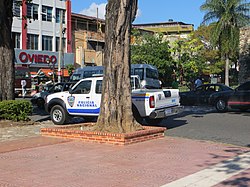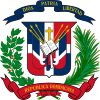Crime in the Dominican Republic

Crime in the Dominican Republic is investigated by the Dominican Republic National Police.
Crime by type
Murder
In 2012, the Dominican Republic had a murder rate of 22.1 per 100,000 population.[1] There were a total of 2,268 murders in the Dominican Republic in 2012.[1]
Illegal drug trade
The Dominican Republic has become a trans-shipment point for Colombian drugs destined to Europe as well as the United States and Canada.[2][3] Money laundering via the Dominican Republic is favored by Colombian drug cartels for the ease of illicit financial transactions.[2] In 2004, it was estimated that 8% of all cocaine smuggled into the United States had come through the Dominican Republic.[4] The Dominican Republic responded with increased efforts to seize drug shipments, arrest and extradite those involved, and combat money-laundering.
Robbery
Purse snatchers and briefcase thieves are known to work hotel bars and restaurants waiting for unknowing guests to place these items on chairs or under tables.[5] Pools or beaches are attractive areas for thieves.[5]
The most common type of crime are drive-by robberies that are normally performed by one or two assailants on a motorcycle, scooter, or even a bicycle.[5] The assailant will drive up and grab anything that is in arm's reach: purses, cellular phones, necklaces, etc..[5] In metropolitan Santo Domingo the majority of the motorcycle robberies occurred between 8pm and 11pm, with 85 percent of the motorcycles involved having two riders.[5]
Kidnapping
Kidnapping is an issue in the Dominican Republic.[5] Victims reported that they were approached by men in police uniforms or similar clothing and were told that their identity needed to be verified.[5] Victims were then taken to an undisclosed location and held from a few hours to a couple of days.[5] During that time, abductors would contact family members and demand huge sums of money for the release of their loved ones.[5] Most families paid the amount, and the victims were released unharmed.[5]
By location
Santo Domingo
High crime areas in the capital include Arroyo Hondo, Naco, Gazcue, Cristo Rey and Villa Agricola.[5]Pantoja
References
- ^ a b Global Study on Homicide. United Nations Office on Drugs and Crime, 2013.
- ^ a b "CIA – The World Factbook – Dominican Republic". Central Intelligence Agency (CIA). Retrieved 2007-06-04.
- ^ NYT 2000-07-09
- ^ Ribando, Claire (2005-03-05). "Dominican Republic: Political and Economic Conditions and Relations with the United States" (PDF). CRS Report for Congress. Retrieved 2007-05-29.
- ^ a b c d e f g h i j k "Dominican Republic 2014 Crime and Safety Report", Overseas Security Advisory Council, US State Department, 10 July 2014.
 This article incorporates text from this source, which is in the public domain.
This article incorporates text from this source, which is in the public domain.


